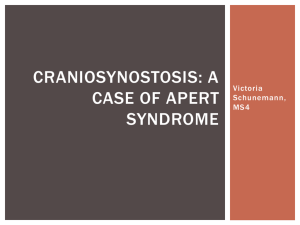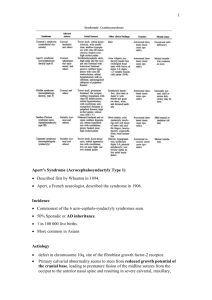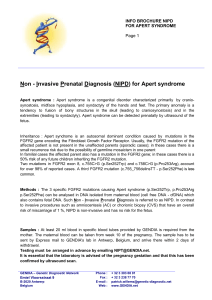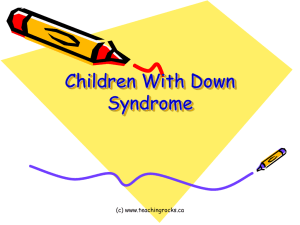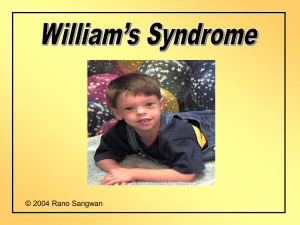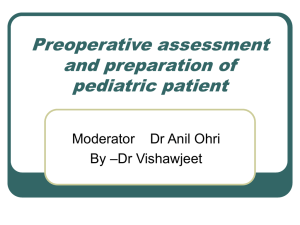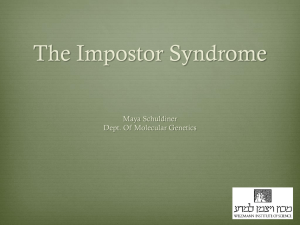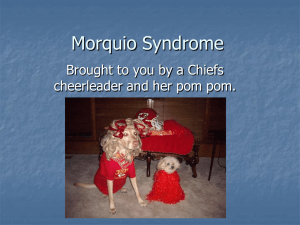Apert Syndrome - Genetic Disorders
advertisement
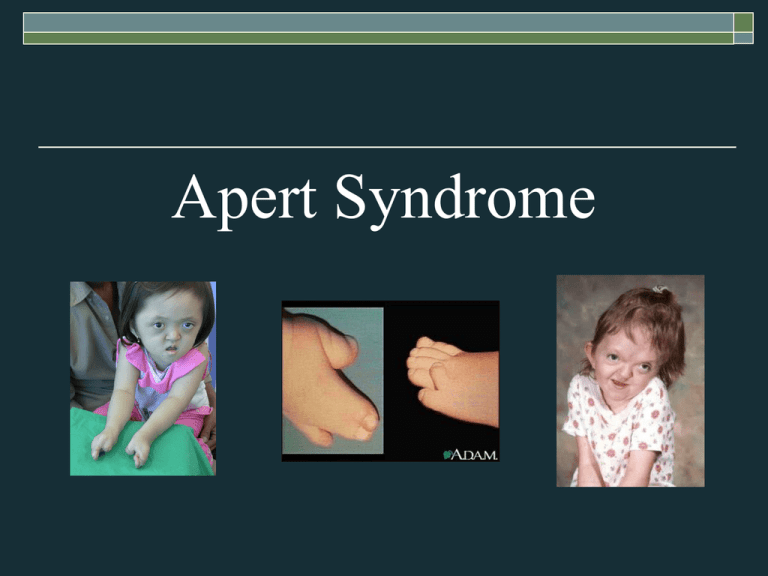
Apert Syndrome What is Apert Syndrome? Apert syndrome is a genetic disorder in which the fingers, face, toes, or feet are mutated. Apert syndrome can be inherited from a parent who has it or through a genetic mutation. A child with Apert syndrome usually has brain plates that have fused together and cause pressure in the head and also physical deformation of the head. Apert syndrome also shows in the fingers and toes. How was Apert Syndrome discovered? Apert syndrome was first described in 1906 by a French physician named Eugene Apert. He found nine different people who all had a disease called acrocephalosyndactyly. Acrocephalosyndactyly is a condition when the bone or skin between the toes and fingers seam together. Who does Apert Syndrome affect? 1 in 65,000 to 88,000 newborns have Apert syndrome. Apert syndrome is usually found in Asians at 22.3 cases per million births whereas Hispanics have the lowest percent of infected at 7.6 cases per million births. Apert syndrome affects males and females equally. It is seen a lot in children with elder fathers. Symptoms Common Apert syndrome complications: Abnormally shaped head and face Malformations of the brain Increased brain pressure Cleft palate Abnormalities of the eyes, including down-slanting palpebral fissures, hypertelorism (wide spacing), exophthalmos (protrusion) Low-set ears, recurrent ear infections and hearing loss Obstruction of the airways Sleep apnoea Learning disability Excessive sweating Severe acne Abnormalities of the heart and blood vessels, gastrointestinal tract, kidneys and genito-urinary organs Causes of Apert Syndrome Apert syndrome is caused by the mutation of chromosome 10, which controls the production of a protein called fibroblast growth factor receptor 2 (FGFR2). The FGFR2 protein controls bone and skin formations. This syndrome is usually found in children of elderly fathers around the age of 50 when it is not inherited. The mutation happens in the sperm. Inheritance Apert syndrome is inherited in an autosomol dominant pattern. This type of inheritance is shown to the right. It means that if one parent has Apert syndrome, and the other is normal, then their children will each have a 50% chance of being infected. Treatment The only treatment of Apert syndrome is surgery. “Cranial reformation” is the procedure of separating plates in a child’s skull which have prematurely fused and cause increased pressure in the brain as it tries to grow. Surgery can also be done on fingers and toes. When the fingers and toes are morphed together, the condition is called syndactyly. It is the most common symptom of Apert syndrome. Prevention Apert Syndrome cannot be cured. However, there are many preventions and treatments to developing complications and to help the child diagnosed to grow normally. This might include seeing various specialists and, or, surgery.
